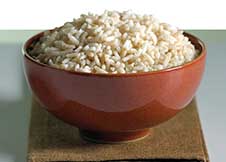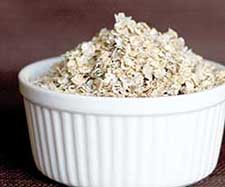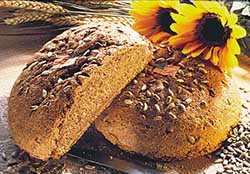Good Things Come in Small Sizes
NUTRACEUTICALS
Ancient grains, whole grains, nutritional seeds, and super seeds. They offer protein, essential fatty acids, fiber, and antioxidants all in one tiny package. These nutritional powerhouses provide benefits associated with heart health, weight management, immunity, and overall wellness.
Consumers are increasingly aware of these tiny yet mighty whole ingredients. According to Innova Market Insights, Duiven, the Netherlands (www.innovadatabase.com), launch numbers for food and drink products containing grains such as quinoa, chia, buckwheat, hemp, and amaranth have been rising strongly in recent years (Innova, 2013). Take a quick look on the internet at nutrition blogs and social media sites like Pinterest. You will find recipes, nutritional information, and reported health benefits for whole grains and seeds like quinoa and chia. These fit some or all of the trends, including whole food ingredients, less processed, gluten-free, and low carbohydrates.
Whole Grains
Today’s mainstream whole grains include oats, whole wheat, barley, and brown rice. They boast reported health benefits such as reduced risk of cardiovascular disease and weight control. Kristensen et al. (2012) demonstrated a potential cardio-protective role for whole grain. The researchers studied the effect of replacing refined wheat with whole grain wheat for 12 weeks on body weight and composition in 79 overweight or obese postmenopausal women. They found that consumption of whole grain products resulted in a greater reduction in the percentage of fat mass, whereas body weight changes did not differ between the subjects who consumed refined wheat and the subjects who consumed whole grain wheat. Serum total and low density lipoprotein cholesterol increased in those who consumed refined wheat but not whole grain wheat, which may suggest a cardioprotective role for whole grain.
 Brown rice has been linked to healthier diets and weight management (USA Rice, 2012b). At the 2012 IFT Annual Meeting & Food Expo, research was presented showing that white or brown rice provided a high level of satisfaction and fullness. Researchers at the Dept. of Food Science and Nutrition at the University of Minnesota conducted a human clinical trial to look at the impact of brown and white rice on satiety in 20 normal weight adult subjects. The results showed that satiety differed significantly, with subjects reporting increased satisfaction and fullness after eating the white rice or brown rice compared to consuming a glucose beverage.
Brown rice has been linked to healthier diets and weight management (USA Rice, 2012b). At the 2012 IFT Annual Meeting & Food Expo, research was presented showing that white or brown rice provided a high level of satisfaction and fullness. Researchers at the Dept. of Food Science and Nutrition at the University of Minnesota conducted a human clinical trial to look at the impact of brown and white rice on satiety in 20 normal weight adult subjects. The results showed that satiety differed significantly, with subjects reporting increased satisfaction and fullness after eating the white rice or brown rice compared to consuming a glucose beverage.
Additionally, a study presented at Experimental Biology 2012 showed eating white or brown rice helped improve diet and manage weight and other risk factors for disease (USA Rice, 2012a). The research conducted at Tufts University Friedman School of Nutrition was based on data from the National Health and Nutrition Examination Survey 2007–2008, and revealed that people who ate rice consumed significantly more folic acid, iron, potassium, and vitamins B-6, B-12, A, and D, and consumed a lower percentage of calories from fat and saturated fat. The benefits of brown rice are that it is a whole grain, gluten-free, and low allergen, and it contributes more than 15 vitamins and minerals.
In addition to whole grain ingredients, ingredient manufacturers offer various whole grain flours for product developers. For example, Horizon Milling, a joint venture of Cargill and CHS, Wayzata, Minn. (www.horizonmilling.com), provides whole wheat flour products, including white spring, stone ground, cracked, and crushed whole wheat flours. WheatSelect® whole wheat flour is milled to a granulation size that preserves the whole grain properties and performs well in a wide variety of baking applications.
ConAgra Mills, Omaha, Neb. (www.conagramills.com), offers Ultragrain® whole wheat flour, made from a proprietary variety of wheat, specially grown to have a sweeter, milder taste and lighter color than conventional wheat. The whole wheat is ground using a patented milling technology that maintains the flour’s mild taste and develops the smooth texture, while preserving the fiber, antioxidants, phytonutrients, and other essential vitamins and minerals found in the whole wheat bran and germ.
Ancient Grains
Ancient grains are increasingly being used in products such as breads, cereals, and bars. The Whole Grains Council, Boston, Mass. (www.wholegrainscouncil.org), offers the following description of ancient grains on its website. “Traditionally hailing from South and Central America, Asia, and Africa, an ‘ancient grain’ refers to grains or seeds that are just that: ancient,” the website states. “These seeds haven’t been modified over time by plant science. Most ‘modern grains’ have been extensively cross-bred to make them easier to grow and ultimately process, while ancient grains remain closer to their original form. Because of this, ancient grains retain a distinctive and rich nutty flavor sure to round out any meal, and are full of beneficial fiber, protein, and other nutrients.”
Ingredient suppliers are helping companies to capitalize on the ancient grain trend with new ingredient offerings. Corbion, Lenexa, Kan.(www.corbion.com), in 2013 introduced Hydrated Ancient Grains, a soaked grain product. Hydrated Ancient Grains contains amaranth, quinoa, and chia, which are all high in protein. The grains are easily added to current bread formulas, can be added on top of current formulations, and contain a blend of hydrated and cooked (soaked) seeds and grains.
Quinoa is one of today’s most recognizable ancient grains. According to Innova, launches of products containing quinoa rose nearly 50% over the 12 months ending September 2013, and have risen more than five-fold over a five-year period. In addition to finding a place in a variety of different grain-based food categories, the use of quinoa in other food product categories is rising and now includes confectionery, beverages, ready meals, and baby foods. There is also a focus on gluten-free formulations; 38% of launches that featured quinoa used a gluten-free positioning. Quinoa is also a good source of protein and offers essential amino acids as well as potassium.
--- PAGE BREAK ---
 The Whole Grains Council has indicated the following grains to keep a lookout for in 2014: amaranth, buckwheat, freekeh, sorghum, and teff (Whole Grains Council, 2014). Amaranth contains, on average, more than three times more calcium than other grains, is high in magnesium and phosphorus, and is a good source of iron. It is gluten-free and has been documented to contain vitamin C. In addition, amaranth is high in protein content. Buckwheat is an excellent source of protein, manganese, tryptophan, magnesium, and dietary fiber. Freekeh is young green wheat that has been toasted and cracked. It is high in fiber. Freekeh offers a whole grain source of selenium, potassium, magnesium, zinc, iron, and protein. Sorghum, which doesn’t have an inedible hull like some other grains, is commonly eaten with its outer layers, which means that all of its nutrients are retained. It is gluten-free and provides antioxidants, calcium, magnesium, potassium, zinc, and niacin.
The Whole Grains Council has indicated the following grains to keep a lookout for in 2014: amaranth, buckwheat, freekeh, sorghum, and teff (Whole Grains Council, 2014). Amaranth contains, on average, more than three times more calcium than other grains, is high in magnesium and phosphorus, and is a good source of iron. It is gluten-free and has been documented to contain vitamin C. In addition, amaranth is high in protein content. Buckwheat is an excellent source of protein, manganese, tryptophan, magnesium, and dietary fiber. Freekeh is young green wheat that has been toasted and cracked. It is high in fiber. Freekeh offers a whole grain source of selenium, potassium, magnesium, zinc, iron, and protein. Sorghum, which doesn’t have an inedible hull like some other grains, is commonly eaten with its outer layers, which means that all of its nutrients are retained. It is gluten-free and provides antioxidants, calcium, magnesium, potassium, zinc, and niacin.
SK Food International Inc., Fargo, N.D. (www.skfood.com), in 2013 has announced the addition of Identity Preserved Non-GMO and Certified Organic Precooked Sorghum Flakes to its line of Premium Quality Ingredients. The precooked sorghum flakes are custom-milled and can be processed according to specific requirements. Teff grains are minute—just 1/150 the size of wheat kernels. Teff is gluten-free and a good source of protein, carbohydrates, calcium, magnesium, and iron.
Super Seeds
Chia seeds are riding high on consumer awareness. They have a high concentration of omega-3 fatty acids (63% of the total fat), and are high in protein, dietary fiber, and antioxidants. According to Innova, chia seeds are showing a similar growth rate to quinoa. Launches of products containing chia seeds rose from probably single figures five years ago to in the hundreds now, with an increase of nearly 50% in the 12 months ending September 2013.
Benexia, Santiago, Chile (www.benexia.com), offers chia seed, chia fiber, and chia oil. Benexia® Chia seed has 1,000 mg of omega-3/5 g and contributes 41 g of fiber/100 g of seed. From the total fiber contributed, 35% is insoluble and 5% is soluble. Benexia Chia seed also contains 21% protein.
Flaxseed’s health benefits are due in large part to its omega-3 essential fatty acids (alpha-linolenic acid), lignans, and fiber. About 42% of flaxseed is oil, and more than 70% of that oil is polyunsaturated fat. Flaxseed is also one of the richest plant sources of lignans. In January 2014, the Flax Council of Canada, Winnipeg, Manitoba (www.flaxcouncil.ca), announced the acceptance of a health claim by Health Canada linking ground whole flaxseed to cholesterol lowering.
Grain Millers Inc., Eden Prairie, Minn. (www.grainmillers.com), in March 2013 launched its new SafeFlax™ line of flaxseed products. More than a year in development, all SafeFlax products undergo a proprietary heat-stabilization and pasteurization treatment developed by Grain Millers. The SafeFlax line includes SafeBake™ and SafeBev™, solutions that have been designed for the baking, cereal, and beverage markets. SafeFlax products will also be used in a variety of mixes that Grain Millers currently sells.
 Sunflower seeds are known for their high vitamin E content. According to the National Sunflower Association, Mandan, N.D. (www.sunflowernsa.com), sunflower seeds offer 76% of the Recommended Dietary Allowance (RDA) for vitamin E, which makes them the richest whole-food source of vitamin E. In addition, most of the vitamin E in sunflower seeds is in the form of alpha-tocopherol. An ounce of sunflower seeds also provides about 25% of daily needs for selenium. They also contain copper, which plays a vital role in antioxidant enzymes in the body. This may further prevent oxidative stress. Sunflower seeds are naturally “low-carb,” provide healthful unsaturated fat and fiber to replace carbohydrates in the diet, and provide 4 g of carbohydrate/1 oz serving, 2 g of which are fiber. They contain 6 g of protein/1 oz serving.
Sunflower seeds are known for their high vitamin E content. According to the National Sunflower Association, Mandan, N.D. (www.sunflowernsa.com), sunflower seeds offer 76% of the Recommended Dietary Allowance (RDA) for vitamin E, which makes them the richest whole-food source of vitamin E. In addition, most of the vitamin E in sunflower seeds is in the form of alpha-tocopherol. An ounce of sunflower seeds also provides about 25% of daily needs for selenium. They also contain copper, which plays a vital role in antioxidant enzymes in the body. This may further prevent oxidative stress. Sunflower seeds are naturally “low-carb,” provide healthful unsaturated fat and fiber to replace carbohydrates in the diet, and provide 4 g of carbohydrate/1 oz serving, 2 g of which are fiber. They contain 6 g of protein/1 oz serving.
Hemp seeds provide protein, omega fatty acids, fiber, antioxidants, and minerals. According to Manitoba Harvest Hemp Foods, Winnipeg, Manitoba (www.manitobaharvest.com), hemp seeds contain a complete and balanced content of all essential amino acids and have an omega-6 to omega-3 ratio of 3.75:1. Hemp seeds are also rich in the omega-6 fatty acid, gamma linolenic acid (GLA). Hemp seeds are an excellent dietary source of protein and contain all of the essential amino acids like arginine, histidine, cysteine, and methionine.
 Linda Milo Ohr,
Linda Milo Ohr, Contributing Editor, Denver, Colo.
[email protected]
References
Innova. 2013. Ancient grains advance on tradition, nutrition and naturalness. Innova Market Insights, Duiven, the Netherlands. Press release, Dec. 16.
Kristensen, M., Toubro, S., Jensen, M.G., Ross, A.B., Riboldi, G., Petronio, M., Bügel, S., Tetens, I., and Astrup, A. 2012. Wholegrain compared with refined wheat decreases the percentage of body fat following a 12-week, energy-restricted dietary intervention in postmenopausal women. J. Nutr. 142(4):710-716.
USA Rice. 2012a. Rice eaters have healthier diets. USA Rice Federation, Arlington, Va. Press release, April 23.
USA Rice. 2012b. Attention dieters: Rice helps fill you up…not out! Press release, June 26.
Whole Grains Council. 2014. A look at 2014’s whole grain trends. Jan. 7. http://wholegrainscouncil.org/newsroom/blog/2014/01/a-look-at-2014s-whole-grain-trends.


